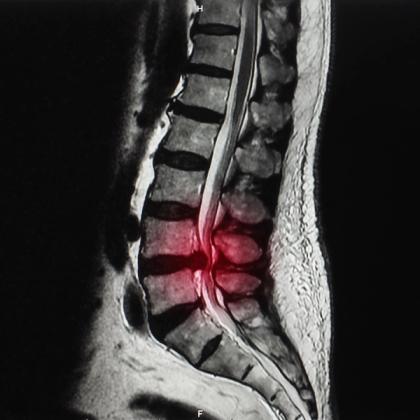This podcast episode is worth 0.34 CPD credits. Upgrade to Pro
Cauda equina syndrome (CES) is caused by compression of the lumbosacral nerve roots that extend below the spinal cord. The most common cause is disc prolapse at the L4/5 or L5/S1 level and stenosis of the spinal canal. Less commonly, compression may be due to pathology in a higher disc or to a tumour, infection or trauma. Typical symptoms and signs of CES include leg and/or back pain, together with one or more of: bladder or bowel dysfunction; altered perianal, perineal or genital sensation; motor weakness affecting both legs; sexual dysfunction. It is a medical emergency and a missed diagnosis can have devastating consequences. In this episode, Dr Roger Henderson covers the anatomy and causes of CES, its presentation, diagnosis and treatment pathway.
Key take-home points
- Injury to the cauda equina nerve roots leads to a lower motor neuron syndrome, often asymmetric, with flaccid paralysis and areflexia.
- Differentiating CES from conus medullaris syndrome can be difficult.
- CES has an estimated annual incidence of 1–3 per 100,000 of the population.
- Approximately 2% of all patients with a lumbar disc herniation will go on to develop CES.
- Herniated lumbar discs remain the most common underlying cause of CES, accounting for nearly half of all cases.
- Patients often present with lower back pain radiating into one or both legs. This pain may be longstanding, or it may have developed acutely. Sciatica is nearly always present in CES, which may be unilateral or bilateral.
- Suspect CES if a patient presents with leg and/or back pain together with onset in the previous 14 days (or deterioration) of any of these four red-flag symptoms: disturbance of bladder or bowel function (sensory changes are particularly significant); altered sensation around the perianal, perineal or genital areas; motor weakness or other neurological deficits affecting both legs; sexual dysfunction.
- Magnetic resonance imaging is the imaging modality of choice, offering detailed views of soft tissue, nerve roots and spinal cord structures.
- Surgical decompression, typically by laminectomy, with or without discectomy, should occur within 24–48 hours of symptom onset.
- Bladder dysfunction at presentation is the single greatest predictor of poor long-term outcome, regardless of surgical timing.
- The extent of any long-term disability closely correlates with the severity of neurological impairment at presentation and rapidity of treatment.
- Bladder, bowel or sexual dysfunction, as well as pain, leg weakness and sensory loss, have been reported in up to 60% of people after surgery.
- Patients require ongoing multidisciplinary support, including physiotherapy, urology input and sometimes psychological counselling.
Key references
- GIRFT. https://girft-interactivepathways.org.uk/cauda-equina-1/.
- NICE. 2020. https://www.nice.org.uk/guidance/ng59.
- Mukherjee S, et al. Br J Hosp Med (Lond). 2013;74(8):460-464. doi: 10.12968/hmed.2013.74.8.460.
- Fairbank J, Mallen C. Br J Gen Pract. 2014;64(619):67-68. doi: 10.3399/bjgp14X676988.
- Germon T, et al. Spine J. 2015;15(3 Suppl):S2-S4. doi: 10.1016/j.spinee.2015.01.006.
- Woodfield J, et al. Lancet Reg Health Eur. 2022:24:100545. doi: 10.1016/j.lanepe.2022.100545.
Create an account to add page annotations
Annotations allow you to add information to this page that would be handy to have on hand during a consultation. E.g. a website or number. This information will always show when you visit this page.
